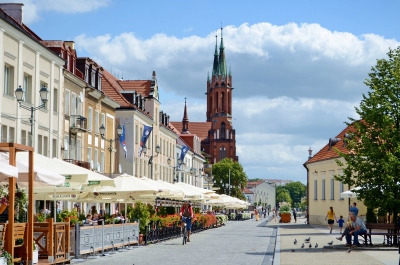Operation Barbarossa (German: Unternehmen Barbarossa) (Russian: ) was the invasion of the Soviet Union by Nazi Germany and most of its Axis allies, starting on Sunday, 22 June 1941, during World War II. The operation, code-named after Frederick Barbarossa ("red beard"), a 12th-century Holy Roman emperor and German king, put into action Nazi Germany's ideological goal of conquering the western Soviet Union to repopulate it with Germans. The German Generalplan Ost aimed to use some of the conquered people as forced labour for the Axis war effort while acquiring the oil reserves of the Caucasus as well as the agricultural resources of various Soviet territories. Their ultimate goal was to create more Lebensraum (living space) for Germany, and the eventual extermination of the indigenous Slavic peoples by mass deportation to Siberia, Germanisation, enslavement, and genocide.In the two years leading up to the invasion, Germany and the Soviet Union signed political and economic pacts for strategic purposes. Following the Soviet occupation of Bessarabia and Northern Bukovina, the German High Command began planning an invasion of the Soviet Union in July 1940 (under the codename Operation Otto). Over the course of the operation, over 3.8 million personnel of the Axis powersthe largest invasion force in the history of warfareinvaded the western Soviet Union along a 2,900-kilometer (1,800 mi) front, with 600,000 motor vehicles and over 600,000 horses for non-combat operations. The offensive marked a massive escalation of World War II, both geographically and in the formation of the Allied coalition including the Soviet Union.
The operation opened up the Eastern Front, in which more forces were committed than in any other theater of war in history. The area saw some of the world's largest battles, most horrific atrocities, and highest casualties (for Soviet and Axis forces alike), all of which influenced the course of World War II and the subsequent history of the 20th century. The German armies eventually captured some five million Soviet Red Army troops. The Nazis deliberately starved to death or otherwise killed 3.3 million Soviet prisoners of war, and millions of civilians, as the "Hunger Plan" worked to solve German food shortages and exterminate the Slavic population through starvation. Mass shootings and gassing operations, carried out by the Nazis or willing collaborators, murdered over a million Soviet Jews as part of the Holocaust.The failure of Operation Barbarossa reversed the fortunes of Nazi Germany. Operationally, German forces achieved significant victories and occupied some of the most important economic areas of the Soviet Union (mainly in Ukraine) and inflicted, as well as sustained, heavy casualties. Despite these early successes, the German offensive stalled in the Battle of Moscow at the end of 1941, and the subsequent Soviet winter counteroffensive pushed the Germans about 250 km (160 mi) back. The Germans had confidently expected a quick collapse of Soviet resistance as in Poland, but the Red Army absorbed the German Wehrmacht's strongest blows and bogged it down in a war of attrition for which the Germans were unprepared. The Wehrmacht's diminished forces could no longer attack along the entire Eastern Front, and subsequent operations to retake the initiative and drive deep into Soviet territorysuch as Case Blue in 1942 and Operation Citadel in 1943eventually failed, which resulted in the Wehrmacht's retreat and collapse.
Białystok is the largest city in northeastern Poland and the capital of the Podlaskie Voivodeship. It is the tenth-largest city in Poland, second in terms of population density, and thirteenth in area.
Białystok is located in the Białystok Uplands of the Podlachian Plain on the banks of the Biała River. It has historically attracted migrants from elsewhere in Poland and beyond, particularly from Central and Eastern Europe. This is facilitated by the nearby border with Belarus also being the eastern border of the European Union, as well as the Schengen Area. The city and its adjacent municipalities constitute Metropolitan Białystok. The city has a warm summer continental climate, characterized by warm summers and long frosty winters. Forests are an important part of Białystok's character and occupy around 1,846 ha (4,560 acres) (18% of the administrative area of the city) which places it as the fifth-most forested city in Poland.
The first settlers arrived in the 14th century. A town grew up and received its municipal charter in 1692. Białystok has traditionally been one of the leading centers of academic, cultural, and artistic life in Podlachia and the most important economic center in northeastern Poland. Białystok was once an important center for light industry, which was the reason for the substantial growth of the city's population. The city continues to reshape itself into a modern middle-sized city. Białystok, in 2010, was on the short-list, but ultimately lost the competition, to become a finalist for European Capital of Culture in 2016.

1941Jun, 27
German troops capture the city of Białystok during Operation Barbarossa.
Choose Another Date
Events on 1941
- 17Mar
Franklin D. Roosevelt
In Washington, D.C., the National Gallery of Art is officially opened by President Franklin D. Roosevelt. - 26Jul
French Indochina
World War II: In response to the Japanese occupation of French Indochina, US President Franklin D. Roosevelt orders the seizure of all Japanese assets in the United States. - 17Sep
Great Patriotic War
World War II: A decree of the Soviet State Committee of Defense, restoring Vsevobuch in the face of the Great Patriotic War, is issued. - 12Dec
Hungary
World War II: The United Kingdom declares war on Bulgaria. Hungary and Romania declare war on the United States. India declares war on Japan. - 14Dec
Thailand
World War II: Japan signs a treaty of alliance with Thailand.

 English
English  español
español  français
français  português
português  русский
русский  العربية
العربية  简体中文
简体中文 